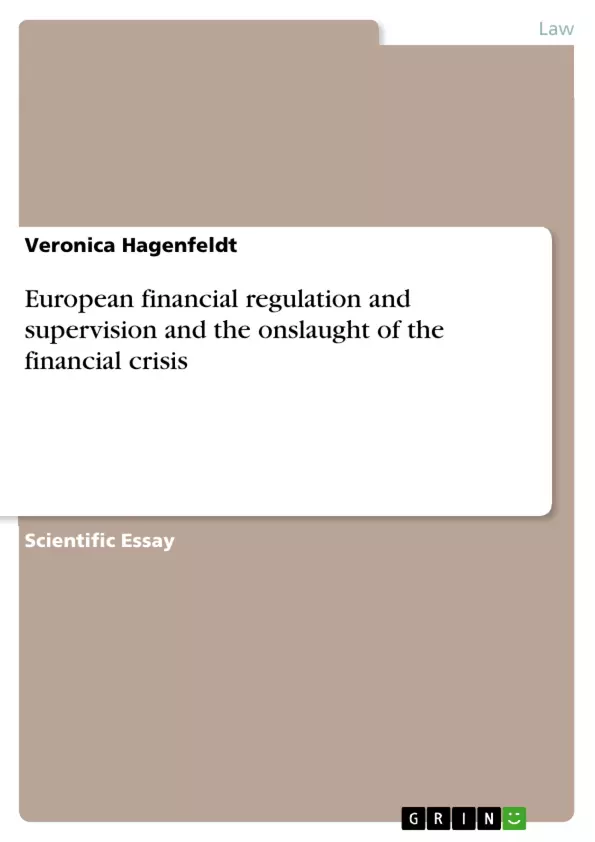The aim of this paper is threefold: first to establish how the regulatory and supervisory architecture has evolved in Europe over the last decade; second to determine how the shortcomings of the present system affected the onslaught of the financial crisis in Europe; and lastly to evaluate whether the proposed regulatory and supervisory reforms are likely to successfully repair these weaknesses. Part I identifies that the single market objective, combined with the significant integration of European financial services, provided the major impetus for bringing about reform to the regulatory and supervisory architecture of Europe. By investigating the Financial Services Action Plan (FSAP) and the implementation of the Lamfalussy Process, this paper illustrates that the member states and the EU institutions sought to achieve a flexible regulatory and supervisory structure marked by cooperation and conversion towards common standards. However, despite the commendable progress made, Part II shows that the regulatory and supervisory system has not kept pace with the financial integration, and that the current crisis revealed substantial inadequacies of the present system. This paper will demonstrate that the weaknesses in the European financial regulatory and supervisory architecture acted both as contributing causes of the crisis, and as exacerbating factors. In particular the essay identifies three such shortcomings that aggravated the crisis, namely that the current system caused a breakdown in member state cooperation and coordination, that it is marked by inconsistency, and that it lacks a sufficiently developed EU-dimension. Lastly, Part III investigates the proposed regulatory and supervisory reforms that the de Larosière Report brought forth. The Report makes recommendations for extensive reform and it is submitted that not only are these reforms likely to cure many of the current cooperation and convergence problems, but they would also equip Europe with a partially centralised supervisory structure that would help prevent future crises of similar cataclysmic proportions.
Inhaltsverzeichnis (Table of Contents)
- INTRODUCTION
- PART I: EVOLUTION OF EUROPEAN REGULATORY AND SUPERVISORY SYSTEM PRIOR TO THE CURRENT CRISIS
- 1.1. The FSAP and the Lamfalussy Process
- PART II: THE WEAKNESSES IN THE EUROPEAN REGULATORY AND SUPERVISORY STRUCTURE THAT BOTH CAUSED AND EXACERBATED THE CRISIS
Zielsetzung und Themenschwerpunkte (Objectives and Key Themes)
This paper aims to analyze the evolution of the regulatory and supervisory architecture in Europe over the past decade, examining how its shortcomings contributed to the onset of the financial crisis. It then evaluates whether proposed reforms are likely to address these weaknesses.
- Evolution of the European regulatory and supervisory architecture
- Shortcomings of the current system that affected the financial crisis
- Proposed regulatory and supervisory reforms
- Impact of the single market objective on financial services
- Role of the FSAP and the Lamfalussy Process in shaping the regulatory framework
Zusammenfassung der Kapitel (Chapter Summaries)
The introductory section outlines the paper's objective, which is to assess the evolution of the European regulatory and supervisory architecture in the context of the financial crisis. It emphasizes the importance of examining the shortcomings of the current system and assessing the potential effectiveness of proposed reforms.
Part I explores the historical development of the European regulatory and supervisory system. It highlights the driving force behind reform, which was the single market objective and the integration of European financial services. The paper then examines the Financial Services Action Plan (FSAP) and the Lamfalussy Process as key initiatives aimed at creating a flexible and cooperative regulatory framework in Europe.
Schlüsselwörter (Keywords)
This paper examines the evolution of European financial regulation and supervision, focusing on the impact of the financial crisis and proposed reforms. Key concepts include the single market, financial services integration, the FSAP, the Lamfalussy Process, cross-border contagion, financial stability, and regulatory and supervisory convergence.
- Citar trabajo
- Veronica Hagenfeldt (Autor), 2009, European financial regulation and supervision and the onslaught of the financial crisis, Múnich, GRIN Verlag, https://www.grin.com/document/169761



